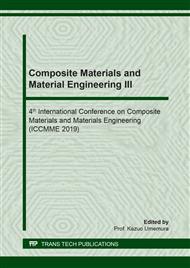[1]
Rahman, F. A., Aziz, M. M. A., Saidur, R., Abu Bakar, W. A. W., Hainin, M. R., Putrajaya, R., & Hassan, N. A. (2017). Pollution to solution: Capture and sequestration of carbon dioxide (CO2) and its utilization as a renewable energy source for a sustainable future. Renewable and Sustainable Energy Reviews, 71, 112-126. http://dx.doi.org/10.1016/j.rser.2017.01.011.
DOI: 10.1016/j.rser.2017.01.011
Google Scholar
[2]
Lee, C. H., Hyeon, D. H., Jung, H., Chung, W., Jo, D. H., Shin, D. K., & Kim, S. H. (2015). Effects of pore structure and PEI impregnation on carbon dioxide adsorption by ZSM-5 zeolites. Journal of Industrial and Engineering Chemistry, 23, 251-256. http://dx.doi.org/10.1016/j.jiec.2014.08.025.
DOI: 10.1016/j.jiec.2014.08.025
Google Scholar
[3]
Lu, W., Sculley, J. P., Yuan, D., Krishna, R., & Zhou, H. (2013). Carbon Dioxide Capture from Air Using Amine-Grafted Porous Polymer Networks. The Journal of Physical Chemistry C, 117, 4057-4061. http://dx.doi.org/10.1021/jp311512q.
DOI: 10.1021/jp311512q
Google Scholar
[4]
Aruldoss, D., Saigoanker, R., Savarimuthu, J. D., & Jagannathan, R. (2014). Amine-grafted zeolites-mesoporous ceramics: Synthesis and adsorption characteristics. Ceramics International, 40, 7583-7587. http://dx.doi.org/10.1016/j.ceramint.2013.11.111.
DOI: 10.1016/j.ceramint.2013.11.111
Google Scholar
[5]
Unveren, E. E., Monkul, B. O., Sarioglan, S., Karademir, N., & Alper, E. (2016). Solid amine sorbents for CO2 capture by chemical adsorption: A review. Petroleum, 1-14. http://dx.doi.org/10.1016/j.petlm.2016.11.001.
DOI: 10.1016/j.petlm.2016.11.001
Google Scholar
[6]
Inoue, S., Koinuma, H., & Tsuruta, T. (1971). Copolymerization of Carbon Dioxide with Optically Active Propylene Oxide. Polymer Journal, 2, 220-224.
DOI: 10.1295/polymj.2.220
Google Scholar
[7]
Zhu, Y., Romain, C., & Williams, C. K. (2016). Sustainable polymers from renewable resources. Nature, 540, 354-362. http://dx.doi.org/10.1038/nature21001.
DOI: 10.1038/nature21001
Google Scholar
[8]
Manoranjan, N., Won, D. H., Kim, J., & Woo, S. I. (2016). Amide linked conjugated porous polymers for effective CO2 capture and separation. Journal of CO2 Utilization, 16, 486-491. http://dx.doi.org/10.1016/j.jcou.2016.05.001.
DOI: 10.1016/j.jcou.2016.05.001
Google Scholar
[9]
Mishra, R. K., Sutar, P. B., Singhal, J. P., & Banthia, A. K. (2007). Graft Polymerization of Pectin with Polyacrylamide. Polymer-Plastics Technology and Engineering, 46, 1079-1085. http://dx.doi.org/10.1080/03602550701525164.
DOI: 10.1080/03602550701525164
Google Scholar
[10]
Adetunji, L. R., Adekunle, A., Orsat, V., & Raghavan, V. (2017). Advances in the pectin production process using novel extraction techniques: A review. Food Hydrocolloids, 62, 239-250. http://dx.doi.org/10.1016/j.foodhyd.2016.08.015.
DOI: 10.1016/j.foodhyd.2016.08.015
Google Scholar
[11]
Gonzalez, A. S., Plaza, M. G., Pis, J. J., Rubiera F., & Pevida, C. (2013). Post-combustion CO2 capture adsorbents from spent coffee grounds. Energy Procedia, 37, 134-141.
DOI: 10.1016/j.egypro.2013.05.094
Google Scholar
[12]
Gonzalez, A. S., Plaza, M. G., Rubiera, F., & Pevida, C. (2013). Sustainable biomass-based carbon adsorbents for post combustion CO2 capture. Chemical Engineering Journal, 230, 465-465.
DOI: 10.1016/j.cej.2013.06.118
Google Scholar
[13]
Sha, Y., Lou, J., Bai, S., Wu, D., Liu, B., & Ling, Y. (2015). Facile preparation of nitrogen-doped porous carbon from waste tobacco by a simple pre-treatment process and their application in electrochemical capacitor and CO2 capture. Materials Research Bulletin, 64, 327-332.
DOI: 10.1016/j.materresbull.2015.01.015
Google Scholar
[14]
Sinitsya, A., Copikova, J., Prutyanov, V., Skoblya, S., & Machovic, V. (2000). Amidation of highly methoxylated citrus pectin with primary amines. Carbohydrate Polymers, 42, 359-368.
DOI: 10.1016/s0144-8617(99)00184-8
Google Scholar
[15]
Gong, B., Wu, P., Huang, Z., Li, Y., Yang, S., Dang, Z., Ruan B., & Kang, C. (2016). Efficient inhibition of heavy metal release from mine tailings against acid rain exposure by triethylenetetramine intercalated montmorillonite (TETA-Mt). Journal of Hazardous Materials, 318, 396-406.
DOI: 10.1016/j.jhazmat.2016.07.011
Google Scholar
[16]
Narayanan, S., Vijaya, J.J., Sivasanker, S., Alam, M., Tamizhdurai, P., & Kennedy, L.J. (2015). Characterization and catalytic reactivity of mordenite – Investigation of selective oxidation of benzyl alcohol. Polyhedron. 89, 289-296. https://doi.org/10.1016/j.poly.2014.12.038.
DOI: 10.1016/j.poly.2014.12.038
Google Scholar


